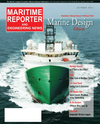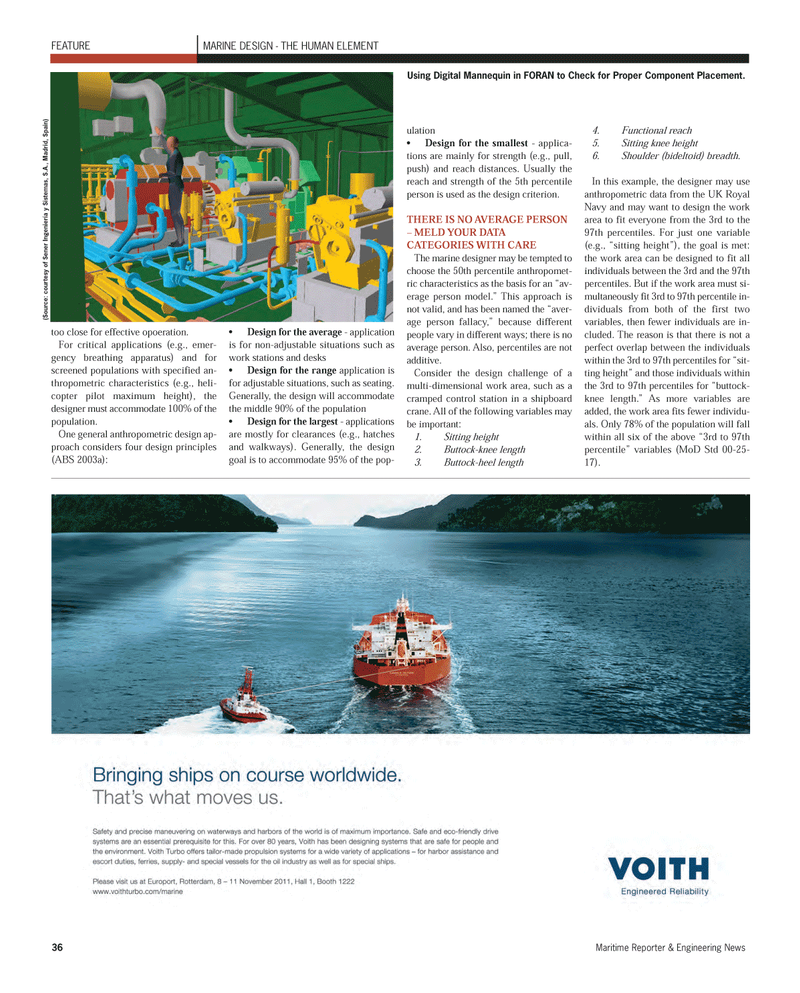
Page 36: of Maritime Reporter Magazine (October 2011)
Marine Design Annual
Read this page in Pdf, Flash or Html5 edition of October 2011 Maritime Reporter Magazine
36Maritime Reporter & Engineering News too close for effective opoeration. For critical applications (e.g., emer- gency breathing apparatus) and for screened populations with specified an- thropometric characteristics (e.g., heli-copter pilot maximum height), thedesigner must accommodate 100% of thepopulation.One general anthropometric design ap-proach considers four design principles(ABS 2003a):Design for the average - applicationis for non-adjustable situations such aswork stations and desks Design for the range application isfor adjustable situations, such as seating.Generally, the design will accommodate the middle 90% of the population Design for the largest - applicationsare mostly for clearances (e.g., hatchesand walkways). Generally, the design goal is to accommodate 95% of the pop-ulationDesign for the smallest - applica-tions are mainly for strength (e.g., pull,push) and reach distances. Usually thereach and strength of the 5th percentileperson is used as the design criterion.THERE IS NO AVERAGE PERSON ? MELD YOUR DATA CATEGORIES WITH CARE The marine designer may be tempted tochoose the 50th percentile anthropomet-ric characteristics as the basis for an ?av- erage person model.? This approach is not valid, and has been named the ?aver- age person fallacy,? because different people vary in different ways; there is no average person. Also, percentiles are not additive. Consider the design challenge of amulti-dimensional work area, such as a cramped control station in a shipboardcrane. All of the following variables may be important:1.Sitting height 2.Buttock-knee length 3.Buttock-heel length 4.Functional reach 5.Sitting knee height 6.Shoulder (bideltoid) breadth. In this example, the designer may use anthropometric data from the UK Royal Navy and may want to design the work area to fit everyone from the 3rd to the 97th percentiles. For just one variable (e.g., ?sitting height?), the goal is met:the work area can be designed to fit all individuals between the 3rd and the 97th percentiles. But if the work area must si- multaneously fit 3rd to 97th percentile in- dividuals from both of the first two variables, then fewer individuals are in- cluded. The reason is that there is not a perfect overlap between the individuals within the 3rd to 97th percentiles for ?sit-ting height? and those individuals within the 3rd to 97th percentiles for ?buttock- knee length.? As more variables are added, the work area fits fewer individu- als. Only 78% of the population will fall within all six of the above ?3rd to 97th percentile? variables (MoD Std 00-25- 17). FEATURE MARINE DESIGN - THE HUMAN ELEMENTUsing Digital Mannequin in FORAN to Check for Proper Component Placement. (Source: courtesy of Sener Ingeniería y Sistemas, S.A., Madrid, Spain) MR Oct.11 # 5 (34-41):MR Template 10/5/2011 12:48 PM Page 36

 35
35

 37
37
